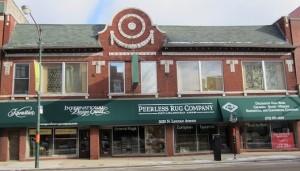A store today, a century ago it was a nickel theater.
A century ago, 1915 was a pivotal year for the motion picture industry in America. The Birth of a Nation had become a national event. The movie had been a sensation and a veritable money-making machine. But the Birth of a Nation was not exhibited in any of the hundreds of existing nickel theaters in Chicago or the thousands elsewhere but rather in large first-class downtown stage theaters. It was the dead knoll for the nickel theaters that had prospered for the past ten years in Chicago since Aaron Jones opened his first nickel theater in 1903 following the success of another movie, The Great Train Robbery.
If the nickel theater moguls of Chicago didn’t hear the dirge, it was perhaps understandable. This was probably the height of their prosperity. It was for Charlie Chaplin movies. If an exhibitor possessed a “little tramp” movie, he had a continuing stream of nickels headed his way. There was a constant line of people waiting to see Charlie Chaplin. This was also the period when the movie serials like Diamond in the Sky were in release and which guaranteed a continuing stream of patrons returning week after week until the big denouement. Then another serial would commence the cycle. How could they foresee that in a matter of months, their segment of the industry would totally collapse. Hundreds of theaters would close as the new mega-theaters based on long-form “feature” movies opened.
The era of the nickel theater was a rather brief ten years, the period between The Great Train Robbery and the Birth of a Nation. In some histories of this era, the theaters are called “nickelodeons,” but that name was rarely used in Chicago. The newspapers and the business directories listed them as nickel theaters while the proprietors prominently displayed a nickel as a major attraction. The business directory for 1914 list well over a 100 active nickel theaters across the city. Over the course of the decade, there would have been more than a thousand. It was a major industry in Chicago and a significant part of the city’s culture. Over the century, most of these old relics of a forgotten era have met their fate to the wrecking ball as some parts of the city decayed while other neighborhoods prospered making the land under the old nickel theater buildings valuable for higher value buildings. Yet there are still a couple of dozen survivors across Chicago although none have a landmark designation as a nickel theater.
For more about Chicago’s nickel theaters click here

